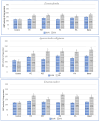Effects of Microplastics on Selected Earthworm Species
- PMID: 40137528
- PMCID: PMC11945361
- DOI: 10.3390/toxics13030201
Effects of Microplastics on Selected Earthworm Species
Abstract
Microplastics currently pose a serious threat to aquatic and terrestrial ecosystems. The high mobility of particles and their diversity in size, material and shape lets them spread widely. Further complicating matters is the ever-expanding plastics industry and modifications to its manufacturing processes. To date, many cases of negative, often toxic effects of microplastics on various species such as fish, birds and mammals have been documented. The methodology for measuring and determining the effects of microplastics on soil organisms is still an area of little understanding and certainly requires further study. In our conducted experiment, we reported the effects of selected microplastics in soil (polyethylene, polyethylene terephthalate, polystyrene, polyamide and a mixture of these plastics) at concentrations of 0.1% w/v and 1% w/v at two time intervals, one and three months, on five different earthworm species, identifying the species-related microplastic response. This study investigated the effects of different microplastics on biological parameters such as survival and respiration and biochemical parameters such as effects on glutathione s-transferase (GST), a marker of detoxification and adaptive response in earthworm species Eisenia andrei, Eisenia fetida, Lumbricus terrestris, Apporectoda caliginosa and Dendrobena veneta. The choices of species and the types of microplastic selected are intended to map the occurrence of microplastic contamination in the soil and determine the adaptation of earthworms to changing environmental conditions, considering their ecological significance and functional diversity in soil ecosystems.
Keywords: adaptive response; earthworms; high-density polyethylene; microplastic.
Conflict of interest statement
The authors declare no conflicts of interest. The funders had no role in the design of the study; in the collection, analyses or interpretation of data; in the writing of the manuscript; or in the decision to publish the results.
Figures










Similar articles
-
Reproduction, growth and oxidative stress in earthworm Eisenia andrei exposed to conventional and biodegradable mulching film microplastics.Sci Total Environ. 2024 Oct 20;948:174667. doi: 10.1016/j.scitotenv.2024.174667. Epub 2024 Jul 10. Sci Total Environ. 2024. PMID: 38992384
-
Negligible effects of microplastics on animal fitness and HOC bioaccumulation in earthworm Eisenia fetida in soil.Environ Pollut. 2019 Jun;249:776-784. doi: 10.1016/j.envpol.2019.03.102. Epub 2019 Mar 28. Environ Pollut. 2019. PMID: 30951961
-
Detecting microplastics in organic-rich materials and their potential risks to earthworms in agroecosystems.Waste Manag. 2023 Jul 1;166:96-103. doi: 10.1016/j.wasman.2023.04.047. Epub 2023 May 9. Waste Manag. 2023. PMID: 37167710
-
The Minderoo-Monaco Commission on Plastics and Human Health.Ann Glob Health. 2023 Mar 21;89(1):23. doi: 10.5334/aogh.4056. eCollection 2023. Ann Glob Health. 2023. PMID: 36969097 Free PMC article. Review.
-
Microplastics in terrestrial ecosystems: Moving beyond the state of the art to minimize the risk of ecological surprise.Glob Chang Biol. 2021 Sep;27(17):3969-3986. doi: 10.1111/gcb.15724. Epub 2021 Jun 13. Glob Chang Biol. 2021. PMID: 34042229 Review.
Cited by
-
Thermoset Polyester Resin Microplastics: Effects on Enzymatic Biomarkers and Toxicological Endpoint Responses of Eisenia fetida Earthworms.Toxics. 2025 Jul 17;13(7):602. doi: 10.3390/toxics13070602. Toxics. 2025. PMID: 40711046 Free PMC article.
References
-
- Briones M.J.I., Moran P., Posada D. Are the sexual, somatic and genetic characters enough to solve nomenclatural problems in lumbricid taxonomy? Soil Biol. Biochem. 2009;41:2257–2271. doi: 10.1016/j.soilbio.2009.07.008. - DOI
-
- Csuzdi C., Zicsi A. Earthworms of Hungary (Annelida: Oligochaeta, Lumbricidae) Hungarian Natural History Museum; Budapest, Hungary: 2003. p. 271.
-
- Adhikari K., Astner A.F., DeBruyn J.M., Yu Y., Hayes D.G., O’Callahan B.T., Flury M. Earthworms Exposed to Polyethylene and Biodegradable Microplastics in Soil: Microplastic Characterization and Microbial Community Analysis. ACS Agric. Sci. Technol. 2023;3:340–349. doi: 10.1021/acsagscitech.2c00333. - DOI
-
- Suleiman H., Rorat A., Grobelak A., Grosser A., Milczarek M., Płytycz B., Kacprzak M., Vandenbulcke F. Determination of the performance of vermicomposting process applied to sewage sludge by monitoring of the compost quality and immune responses in three earthworm species: Eisenia fetida, Eisenia andrei and Dendrobaena veneta. Bioresour. Technol. 2017;241:103–112. doi: 10.1016/j.biortech.2017.05.104. - DOI - PubMed
LinkOut - more resources
Full Text Sources
Research Materials

